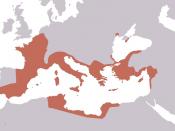The use of symbolism in plays and poems
Symbolism is the use of a person, an object, a place, or an idea to represent it self and something beyond itself at the same time. Two recognizable examples of symbolism are the Stars and Stripes on the flag; this is the symbol for the United States of America. Another well-known symbol is skull and crossbones, which we all know represent something poisonous. Symbolism is often used in all forms of literature and poetry. Many use it because it helps the writer to get their expressions out more clearly (Prentice Hall Literature 619).
Some symbols can be read clearly and understood with ease but there are others, which have private meanings. Symbols with private meanings usually cannot be comprehended at first glance but instead you have to really understand the text in which you are reading. In order to get the exact meaning of a private symbol you must appreciate the literary work in which you are reading (Prentice Hall Literature 619).
More frequently used and most recognizable uses of symbolism in today's society are youth, which symbolizes springtime, middle age, which is summer, and old age, which is autumn or winter. Also there is death, which is darkness or cold, roses are used for love and beauty, and doves are for peace and owls, which symbolizes wisdom. Two writhers who could be symbolizing by an owl are William Shakespeare and William Blake (Prentice Hall Literature 619).
William Shakespeare and William Blake can both be considered as two of the greatest writhers in their time. Though Shakespeare wrote plays and Blake wrote poems there still remain many similarities between the two. These two writers became familiar with symbolism and decided to take their poems and plays to the extreme. Both figured...



Good essay
good essay for such an extensive topic.
6 out of 6 people found this comment useful.